Resolving Rotator Cuff Injuries
 Injuries to the rotator cuff and its tendons are very common. In younger patients, injuries are usually caused either by repetitive actions or by sudden trauma.
Injuries to the rotator cuff and its tendons are very common. In younger patients, injuries are usually caused either by repetitive actions or by sudden trauma.
With older patients, we often see these injuries when the patient attempts to reach overhead (sometimes repeatedly). In such cases, the injury is typically caused by an age-related decrease in the elasticity of muscles and tendons.
Swimmer’s Shoulder is a common name that is applied to rotator cuff injuries.
Resolving Injuries to the Rotator Cuff
Effective resolution of injuries to the rotator cuff requires a combination of the effective soft-tissue treatments (such as Active Release Techniques), an ability to evaluate biomechanical impacts of the injury upon other structures in the body, and a rehabilitative exercise strategy that addresses all the structures in the shoulder’s kinetic chain.
Click on each of the following tabs to better understand our treatment process.
- Rotator Cuff Anatomy
- Causes of Rotator Cuff Injuries
- Effects of Rotator Cuff Injuries
- Treating with ART
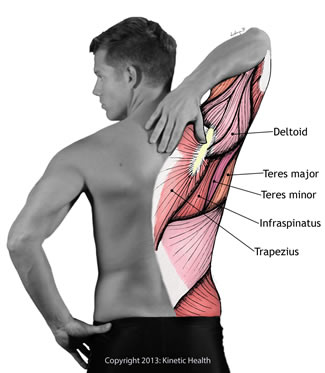 About the Rotator Cuff Muscles and Tendons
About the Rotator Cuff Muscles and Tendons
The rotator cuff is made up of four major muscles and their associated tendons:
- Supraspinatus
- Infraspinatus
- Teres minor
- Subscapularis
The rotator cuff muscles serve several key functions including:
- Generating torque for shoulder movement.
- Acting as dynamic stabilizers of the shoulder joint (glenohumeral joint).
- Aiding in lowering and stabilizing the humeral head (end of the humerus bone) that fits into the shoulder joint.
Causes of Rotator Cuff Injuries
 A restriction, shortening, or change in length of any one of the muscles in the rotator cuff can immediately affect the balance, movement, and function of the shoulder.
A restriction, shortening, or change in length of any one of the muscles in the rotator cuff can immediately affect the balance, movement, and function of the shoulder.
Rotator cuff injuries are a common consequence of repetitive overhead activities such as tennis, swimming, baseball, and weight-training.
Chronic pain in any sport that involves reaching overhead is often the result of damage to the rotator cuff muscles.
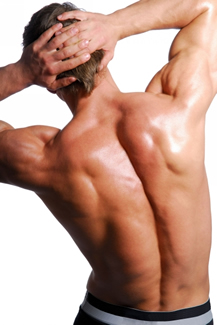 Effects of Injuries to the Rotator Cuff
Effects of Injuries to the Rotator Cuff
No matter what the cause, it is often quite difficult to pinpoint the actual location of a rotator cuff tear. Patients often describe the pain as covering a broad area over the shoulder, often with pain radiating down the arms and elbows.
- When the rotator cuff is partially torn, the patient generally complains about the pain.
- If there has been a complete tear of the rotator cuff, the patient will not be able to perform certain motions with their shoulder.
Resolving Rotator Cuff Injuries with ART
 Many rotator cuff tears can cause significant disability if left untreated. Conservative treatments such as Active Release Techniques (ART) and exercise rehabilitation should always be tried before surgery is performed.
Many rotator cuff tears can cause significant disability if left untreated. Conservative treatments such as Active Release Techniques (ART) and exercise rehabilitation should always be tried before surgery is performed.
Identifying the Injured Structures
For most cases, a simple physical examination is all that is needed to diagnosis this condition. Combined with biomechanical analysis, it is often possible to identify which structures have been most impacted by this rotator cuff injury.
The exception occurs when there are indications of a complete tear – such as an inability to perform certain motions. Tears to the rotator cuff cannot be seen on X-rays. Typically, you will need an ultrasound or MRI (magnetic resonance imaging) to confirm a full tear of the rotator cuff.
Fortunately, most tears of the rotator cuff do not need surgical intervention. In most cases, a rotator cuff injury can be easily treated with a combination of ART procedures and exercise. However, effective treatment does require a good understanding of the biomechanics of the shoulder and its kinetic chain, since much more than just the rotator cuff should be addressed in any treatment protocol.
More Information about Rotator Cuff Injuries
Dr. Abelson provides a broad range of information to his patients and the public. They range from published books (eBook and hard-copy), to blogs, YouTube Videos, websites, and articles. Click on the following tabs to access some of his more popular information resources.
Books for Resolving Rotator Cuff Injuries
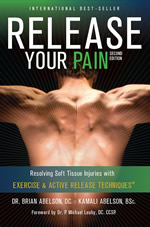 Release Your Pain: 2nd Edition
Release Your Pain: 2nd Edition
Dr.Abelson’s international best-seller – Release Your Pain – provides a detailed description about the anatomy, kinetic chain, and causes of Rotator Cuff Injuries. It discusses means for resolving this condition, and provides specially selected exercises to help you begin the process of resolution. Visit our website at www.releaseyourbody.com to purchase your eBook or hard-Copy.
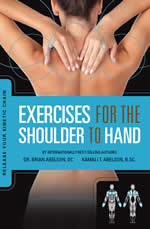 Release Your Kinetic Chain: Exercises for the Shoulder to Hand
Release Your Kinetic Chain: Exercises for the Shoulder to Hand
The phased exercise routines in Exercises for the Shoulder to Hand are designed to build and strengthen the neuromuscular relationships in the structures from your hand to shoulders. These exercises are a critical component of any treatment plan for the resolution of a Rotator Cuff Injury. Visit our website at www.releaseyourbody.com to purchase your eBook or hard-Copy.
Release Your Kinetic Chain: Exercises for the Jaw to Shoulder
The specially designed exercise routines in Exercises for the Jaw to Shoulder provide a unique set of exercises that can help you to resolve Rotator Cuff Injuries. These exercises include self-massage techniques, and exercises that work to strengthen and stretch the muscles of the shoulder and neck’s kinetic chain. Visit our website at www.releaseyourbody.com to purchase your eBook or hard-copy.
Exercise Videos for Rotator Cuff Injuries
The following videos by Dr. Abelson provide extra information about Rotator Cuff Injuries, its kinetic chain, as well as exercises to help resolve this condition. Click on the left and right arrows to scroll through these videos.
- Body Worlds – Shoulder Injuries – A Kinetic Chain Approach
- Click To PlayPlay Video
Understand how the restrictions in the structures of your shoulder, neck, and back can cause shoulder pain, rotator cuff injuries and a wide array of other problems. Learn how releasing restrictions throughout this kinetic chain can provide a resolution to your shoulder problems.
- Shoulder Injuries
- Shoulder Exercises – L’s – Retract your Scapula
- Click To PlayPlay Video
One of the essential exercises with any shoulder injury. We often combine this exercise with Y’s and T’s on the Swiss Ball.
- Shoulder Exercises – T’s on the Swiss Ball
- Click To PlayPlay Video
This shoulder exercise is great for training scapular movement after an injury. An essential exercise after a shoulder injury.
- Shoulder Exercises – Y’s On The Swiss Ball
- Click To PlayPlay Video
This exercise focuses on straightening the upper shoulders, rotator cuff and mid-thoracic area. (Traps, Rhomboids, posterior deltoid, and upper thoracic paraspinals)
- Shoulder Exercise – The Four Cardinal Planes
- Click To PlayPlay Video
Ball circles against the wall and Four Cardinal Points both work on proprioception, balance, and coordination of the shoulder and its surrounding muscles.
- Shoulder Exercise – Setting and Activating the Scapula
- Click To PlayPlay Video
This exercise helps you to build awareness of where the scapula (shoulder blade) is and learn what its normal position should be. A key position in performing the exercises found in the “Exercises For The Shoulder To Hand” book.
Blogs about Rotator Cuff Injuries
Click on the following blog articles for additional information on Rotator Cuff Injuries.
Shoulder Injuries – The Rotator Cuff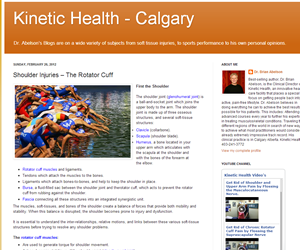
The shoulder joint (glenohumeral joint) is a ball-and-socket joint which joins the upper body to the arm. The shoulder joint is made up of three osseous structures, and several soft-tissue structures. The muscles, soft-tissues, and bones of the shoulder create a balance of forces that provide both mobility and stability. When this balance is disrupted, the shoulder becomes prone to injury and dysfunction.
 Rotator Cuff Injuries, the Scapula and Impingement Syndromes – Part 1
Rotator Cuff Injuries, the Scapula and Impingement Syndromes – Part 1
A rotator cuff tear is a very common injury. These injuries are usually caused by either repetitive motion or trauma. These injuries in the older population are often due to a decrease in elasticity of muscles and tendons that occurs with the aging process.
- Rotator Cuff Injuries, the Scapula and Impingement Syndromes–Part 2
- Rotator Cuff Injuries, the Scapula and Impingement Syndromes–Part 3
- Rotator Cuff Injuries, the Scapula and Impingement Syndromes–Part 4
For information about our clinic in Calgary, Alberta, please visit to www.kinetichealth.ca.
(COPYRIGHT KINETIC HEALTH 2013 – ALL RIGHTS RESERVED)
